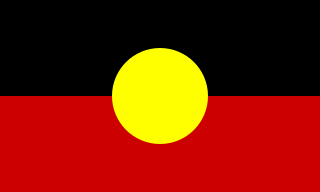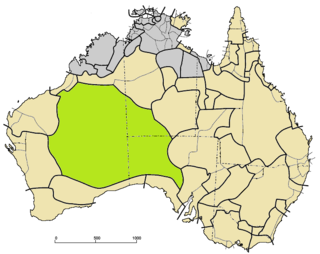Related Research Articles

The Indigenous languages of Australia number in the hundreds, the precise number being quite uncertain, although there is a range of estimates from a minimum of around 250 up to possibly 363. The Indigenous languages of Australia comprise numerous language families and isolates, perhaps as many as 13, spoken by the Indigenous peoples of mainland Australia and a few nearby islands. The relationships between the language families are not clear at present although there are proposals to link some into larger groupings. Despite this uncertainty, the Indigenous Australian languages are collectively covered by the technical term "Australian languages", or the "Australian family".
The Kaurna people are a group of Aboriginal people whose traditional lands include the Adelaide Plains of South Australia. They were known as the Adelaide tribe by the early settlers. Kaurna culture and language were almost completely destroyed within a few decades of the British colonisation of South Australia in 1836. However, extensive documentation by early missionaries and other researchers has enabled a modern revival of both language and culture. The phrase Kaurna meyunna means "Kaurna people".

Morgan is a town in South Australia on the right bank of the Murray River, just downstream of where it turns from flowing roughly westwards to roughly southwards. It is about 161 kilometres (100 mi) north east of Adelaide, and about 315 kilometres (196 mi) upstream of the Murray Mouth.

Melrose is the oldest town in the Flinders Ranges, South Australia. The town was once named "Mount Remarkable".

The Peramangk are an Aboriginal Australian people whose lands traditionally comprise the Adelaide Hills, as well as lands to the west of the Murray River in mid Murraylands and through to the northern part of the Fleurieu Peninsula in the Australian state of South Australia.

Aboriginal Australians are the various Indigenous peoples of the Australian mainland and many of its islands, excluding the ethnically distinct people of the Torres Strait Islands.
Kaurna is a Pama-Nyungan language historically spoken by the Kaurna peoples of the Adelaide Plains of South Australia. The Kaurna peoples are made up of various tribal clan groups, each with their own parnkarra district of land and local dialect. These dialects were historically spoken in the area bounded by Crystal Brook and Clare in the north, Cape Jervis in the south, and just over the Mount Lofty Ranges. Kaurna ceased to be spoken on an everyday basis in the 19th century and the last known native speaker, Ivaritji, died in 1929. Language revival efforts began in the 1980s, with the language now frequently used for ceremonial purposes, such as dual naming and welcome to country ceremonies.

The Western Desert language, or Wati, is a dialect cluster of Australian Aboriginal languages in the Pama–Nyungan family.

Australia, officially the Commonwealth of Australia, is a country comprising the mainland of the Australian continent, the island of Tasmania and numerous smaller islands. Australia has a total area of 7,688,287 km2 (2,968,464 sq mi), making it the sixth-largest country in the world and the largest in Oceania. It is the world's oldest, flattest, and driest inhabited continent, with some of the least fertile soils. It is a megadiverse country, and its size gives it a wide variety of landscapes and climates including deserts in the interior and tropical rainforests along the coast.
Yir-Yoront was a Paman language spoken in two settlements, Kowanyama and Pormpuraaw on the southwestern part of the Cape York Peninsula, Queensland in Australia, by the Yir-Yoront people. In 1991 only 15 speakers remained, with the rest of the Yir-Yoront people speaking English or even Kuuk Thaayorre as many speakers of Yir-Yoront apparently are using Kuuk Thaayorre in daily conversation. At present it is thought to be extinct. There are two sister dialects, Yir-Yoront proper and Yirrk-Thangalkl, which are very close. The shared name Yir is sometimes used for both taken together.

Noongar, also Nyungar, is an Australian Aboriginal language or dialect continuum, spoken by some members of the Noongar community and others. It is taught actively in Australia, including at schools, universities and through public broadcasting. The country of the Noongar people is the southwest corner of Western Australia. Within that region, many Noongar words have been adopted into English, particularly names of plants and animals.
Aboriginal Australian kinship comprises the systems of Aboriginal customary law governing social interaction relating to kinship in traditional Aboriginal cultures. It is an integral part of the culture of every Aboriginal group across Australia, and particularly important with regard to marriages between Aboriginal people.
Biri, also known as Biria, Birri Gubba, Birigaba, Wiri, Perembba and other variants, is an Australian Aboriginal language of the Mackay area of Queensland spoken by the Birri Gubba people. There are at least eight languages regarded as dialects of Biri, and two which are related but whose status is not yet fully determined. All are covered in this article.

The Macro-Gunwinyguan languages, also called Arnhem or Gunwinyguan, are a family of Australian Aboriginal languages spoken across eastern Arnhem Land in northern Australia. Their relationship has been demonstrated through shared morphology in their verbal inflections.
The Erawirung people, also known as Yirau, Juju and other names, were an Aboriginal Australian people whose traditional territory was located in what is today the Riverland of South Australia. They consisted of sub-groups or clans, including Jeraruk, Rankbirit and Wilu, and have been referred to as Meru people, which was a larger grouping which could also include the Ngawait and Ngaiawang peoples.
The Ngaiawang (Ngayawang) were an Aboriginal Australian people of the western Riverland area of South Australia, with a language considered part of the Lower Murray group. They are now considered extinct. They have sometimes been referred to as part of the Meru people, a larger grouping which could also include the Ngawait and Erawirung peoples. They were called Birta by the Kaurna and Ngadjuri peoples, variations of Murundi by the Jarildekald people, and were also known various other terms and spellings.
The Nganguruku are an indigenous Australian people of the state of South Australia.
The Ngawait, also spelt Ngawadj and other variations, and also known as Eritark and other names, were an Aboriginal Australian people of the mid-Riverland region, spanning the Murray River in South Australia. They have sometimes been referred to as part of the Meru people, a larger grouping which could also include the Ngaiawang and Erawirung peoples. There were at least two clans or sub-groups of the Ngawait people, the Barmerara Meru and Muljulpero maru.
Warrulan was an Aboriginal Australian, who migrated to England as a boy. He was educated in agriculture and found work as a saddlemaker, dying as a young man before his hoped-for return to his homeland.
References
- ↑ S7 Ngaiawang at the Australian Indigenous Languages Database, Australian Institute of Aboriginal and Torres Strait Islander Studies (see the info box for additional links)
- ↑ Horgen, Michael (2004). The languages of the Lower Murray. LaTrobe University. pp. 45–56.